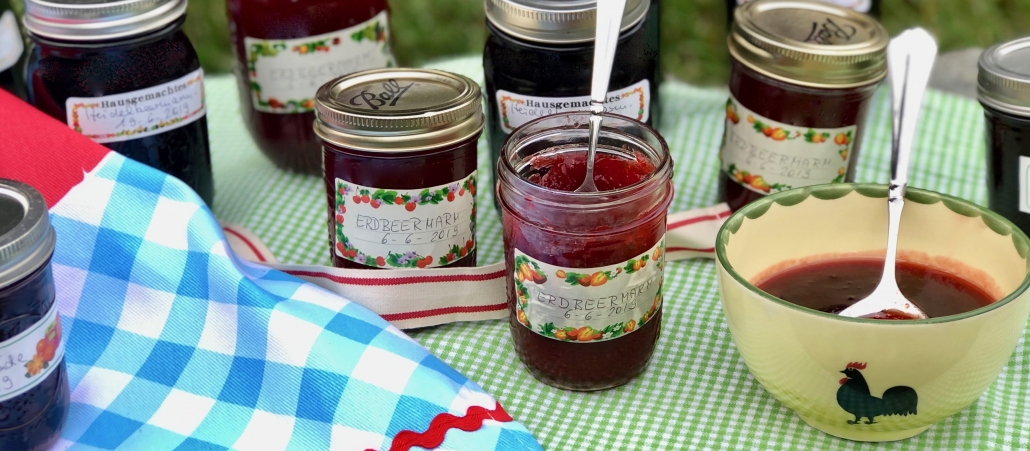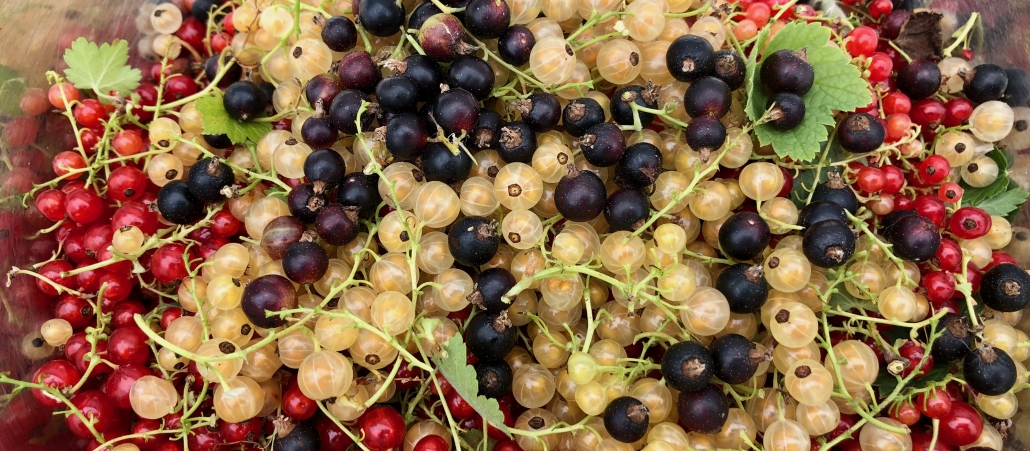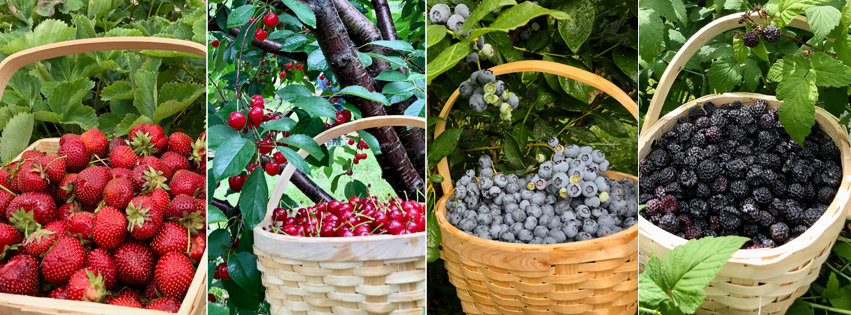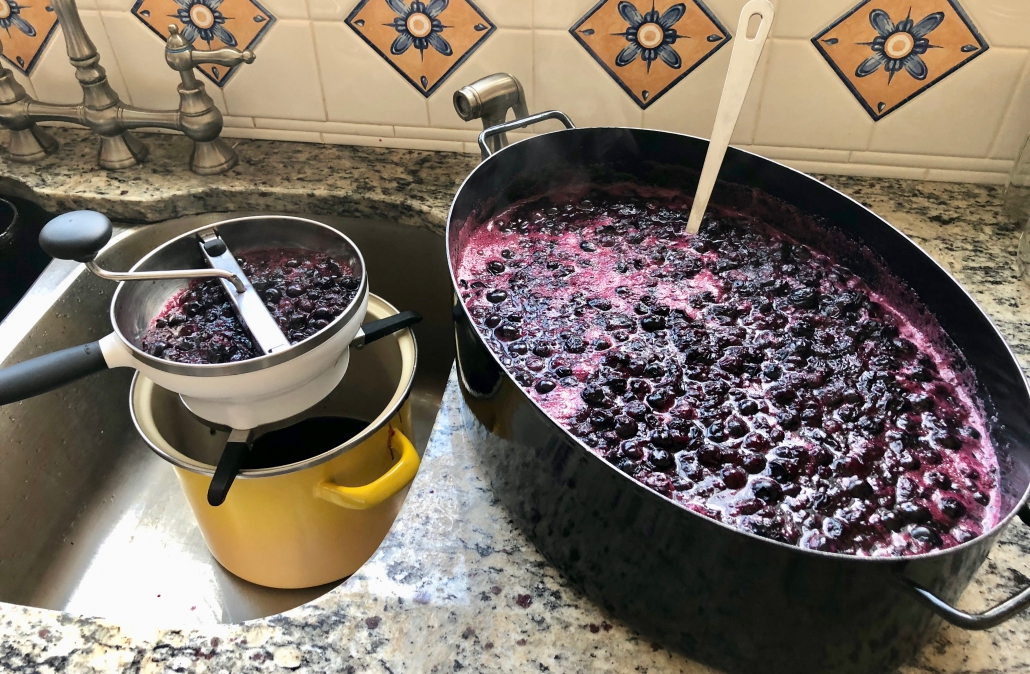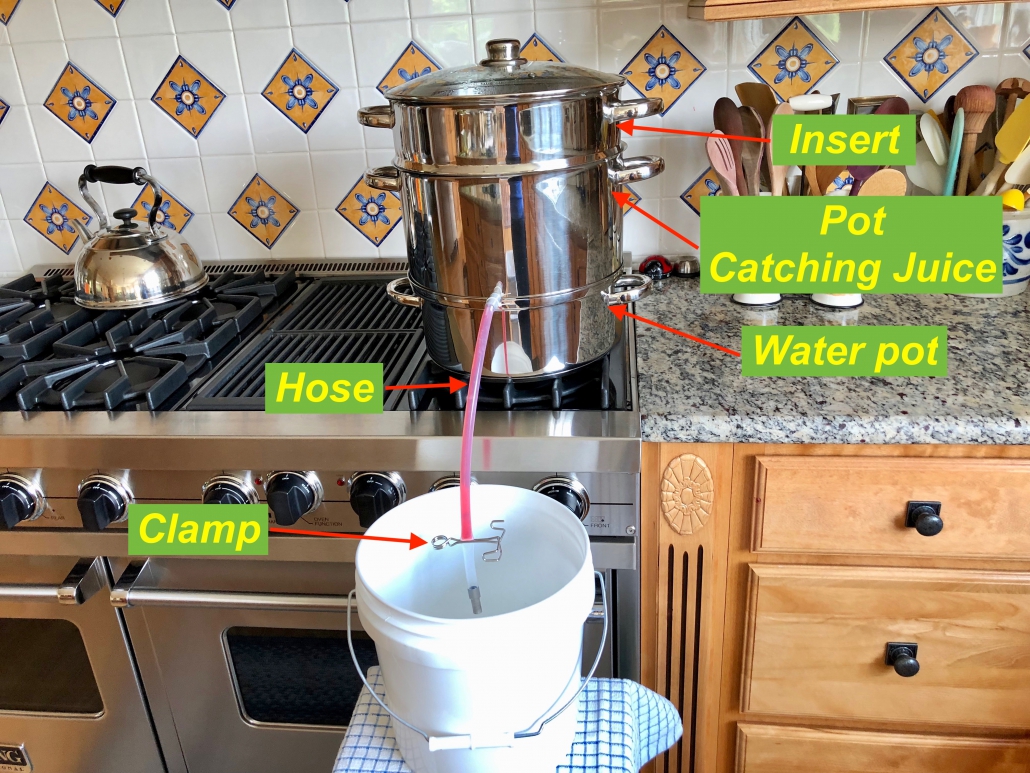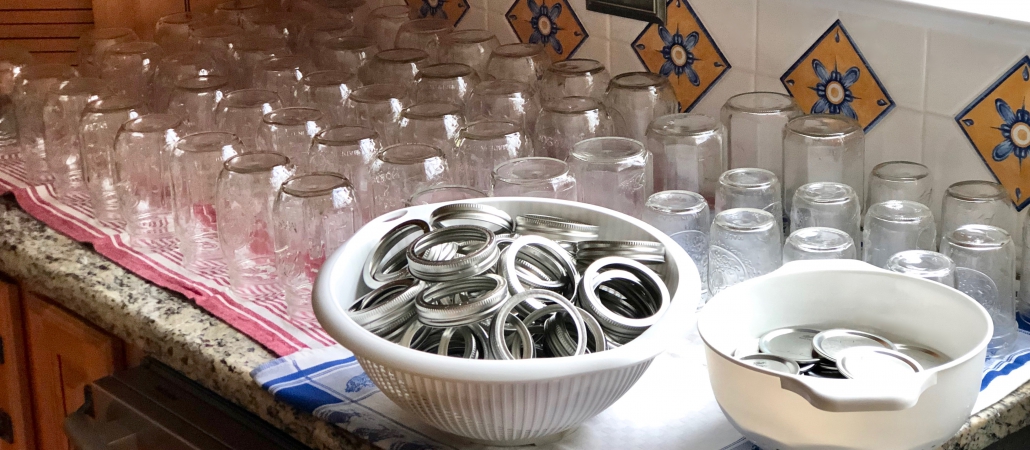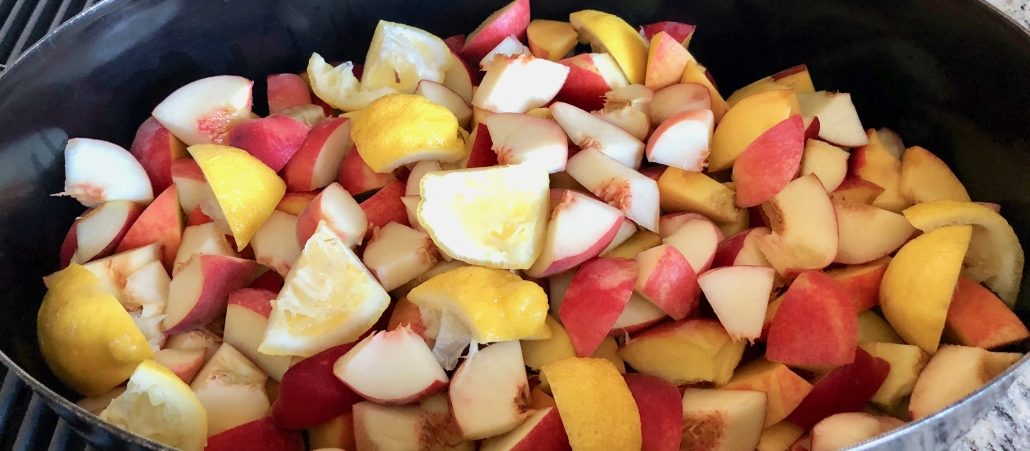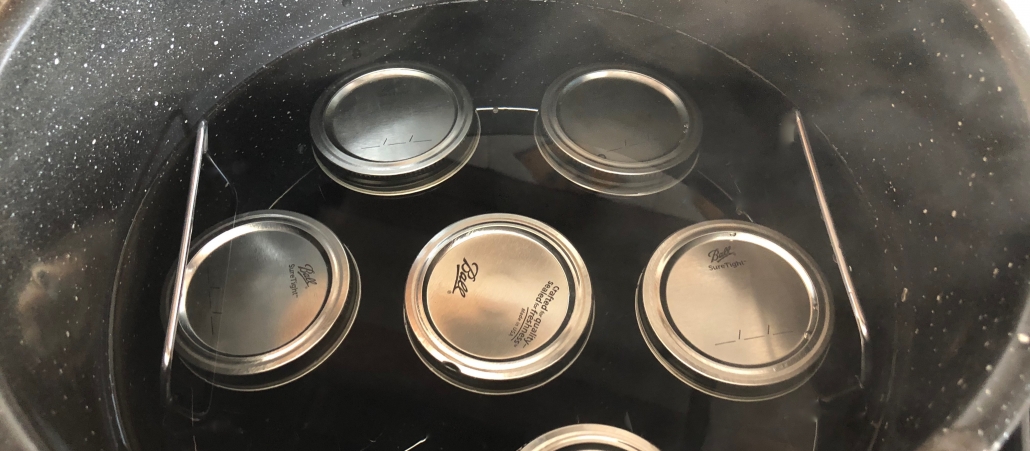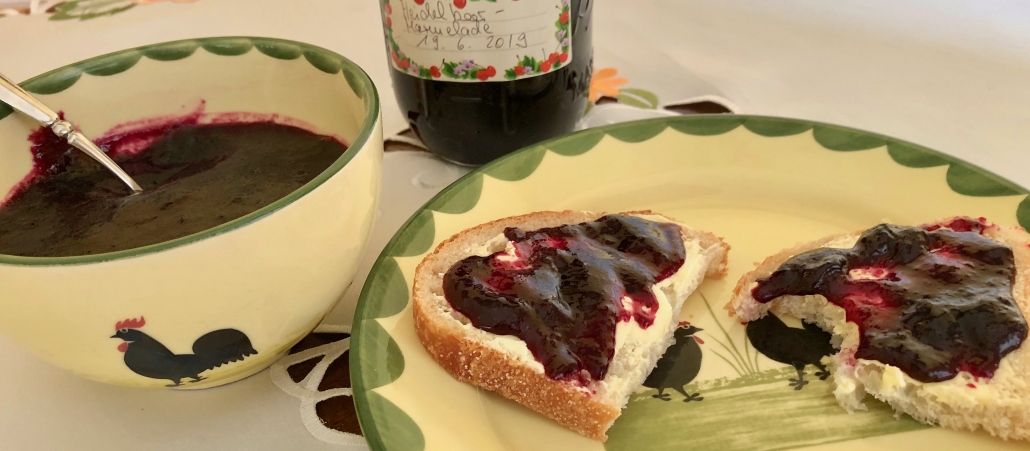Homemade Jam and Jellies
Homemade Jam and Jellies Recipe – and what to know
A variety of methods are known for preparing homemade jam and jellies. June has arrived, and week by week we can witness the ripening of another kind of fruit or berries ready for picking. It starts at the beginning of June with the strawberries, continues with the tart cherries followed by the blueberries and black raspberries, not to forget the currants in red, white, and black growing in my backyard.
Having mostly relied on the use of German products for making the fruit goodies in the past, I felt like experimenting a little this year with American pectin products to get a sense of what is possible. There is always the possibility of making the marmalade and jelly without pectin altogether and relying on the good old use of just lemon juice and sugar. The outcome of the final product may vary depending on the kind of fruit. However, note that this approach requires a longer cooking time.
What fruit to pick
Only good quality fruit should be used. The fruit needs a decent amount of pectin and acid to gel properly. Less ripe fruit has a high amount of pectin and acid, over-ripe, mature fruit has a decrease of both the pectin and acids. Best is, to mix the fruit – part fruit that just ripened for the pectin and acid, and part mature fruit for the color and flavor. Some of the fruit has enough pectin, but not enough acid and vice versa. A variety of products are available to compensate for the missing amount of pectin or acid.
The underlying basics of both jam and jelly are equal parts of sugar and crushed fruit or fruit juice, and lemon juice and/or pectin. What method I use depends on the concentration of pectin and acid in the fruit. The higher the amount of both in the fruit, the easier it will gel. To make up for the missing acid, I use lemon juice.
Pectin and Acid-Rich Fruits explained
Fruits with a high concentration of pectin include citrus fruits, sour apples, quinces, currants, gooseberries, and blueberries. Fruits with a medium amount of pectin include apricots, plums, peaches, nectarines, black raspberries, raspberries, and pears. Bananas, strawberries, cherries, mangos, rhubarb, pineapples, grapes, and oranges have a low amount of pectin.
Fruit with a high concentration of acids is Black Raspberry (early), black currant, cherries, citrus fruit, green apples, pineapple, plums, raspberries (First), and Red Currants.
To get about 1 Liter – 1.05 quarst of fruit juice for jelly you need approximately 1.8 kg (4 lbs) apples, 2.7 kg (6 lbs) pears, 1.5 kg (3.3 lbs) black raspberries, 1.3 kg (2.86 lbs) strawberries, 1.8 kg (4 lbs) raspberries, 1.5 kg (3.3 lbs) red currants, 1.7 kg (3.7 lbs) black currants, 1.7 kg (3.7 lbs) peaches, 2.3 kg (5 lbs) quinces, 1.5 kg (3.3 lbs) rhubarb, 1.6 kg (3.5 lbs) tart cherries, 1.6 kg (3.5 lbs) gooseberries, and 1.7 kg (3.7 lbs) grapes.
I prefer to pick the fruit and berries myself at an orchard or buy them at a Farmers Market.
Kitchen gadgets and tools necessary
A roasting pan or large pot, food mill, which comes with three different inserts, a fruit juice steamer, canning pot, and canning tongs.
Furthermore, Mason jars with lids, both washed and cleaned in a large pot with boiling water. I dry the glasses on a kitchen towel upside down until used. The clean tops can be kept in a strainer covered with a kitchen towel. Also necessary is a kitchen scale, measuring cup, ladle, strainer spoon, wooden spoon, funnel, and lemon press or lemon squeezer.
Preparation of the homemade jam and jellies
What is the difference between jelly and jam? Jelly is prepared with the fruit juice whereas the jam is prepared with fruit pulp or crushed fruit. The measurement of the calculation of sugar, pectin, and lemon juice for jellies is in liquids, the measurement for the jam in weight.
Jelly:
To make the jelly, wash the fruits, rinse the berries in a colander under running water. Remove the stems of cherries, strawberries, and currants. Take the stone out of the larger fruit and cut it into smaller pieces. Place them in the insert of the steamer, then the insert in the pot and cover. Fill the lower part of the juicer with water before setting the covered fruit on top. Bring the water to a boil. The steam softens the fruit, and the juice will run through the hose into a bucket or other container to catch it. The clamp is attached to the hose until the liquid flows. To press a little more juice out, slightly mash the fruits in the insert with a potato masher. If some fruit pieces come out, pass the caught juice through a fine sieve covered with a cheesecloth. Measure the fruit juice in liters/quarts with a measuring cup.
Jam:
Wash the fruits, rinse the berries in a colander under running water. Remove the stems and stones, take the core out, peel if necessary, and cut the larger fruit in small pieces. Place the prepared fruit into a large pot and add about 1 – 1 ½ cups of water.
Bring to a boil, turn the heat back and let the fruit simmer for about 5-10 minutes depending on the kind. Stir from time to time to make sure the fruit doesn’t stick to the bottom of the pot. Pass the fruit through a food mill into a container. Measure the weight in Grams/Ounces with a kitchen scale.
The cooking of the jam and jellies
The jams and the jellies are cooked in the same way. Mix the crushed fruit/fruit juice with the same amount of sugar and follow the directions on the package of the pectin you use. If you want to make the jam/jelly without pectin add the amount of lemon juice needed and cook for about 30-40 minutes. For two pounds of fruit with high pectin about 2 tablespoons of lemon juice and for two pounds of fruit with low pectin about 4 tablespoons of lemon juice. Skim the foam off that builds upon the surface during the cooking.
To test if the jam/jelly is ready, take a small plate from the freezer, spread some of the liquid onto the plate and let it stand for 1 minute in the freezer. If it wrinkles when you move the plate in circles and is not running, the marmalade or jelly is ready.
Finishing the jam and jellies
Remove the pot from the stove. Insert a funnel into the glass and fill the glass through the funnel with a ladle. Leave 0.7 mm – 1/4 in space to the rim. Wipe the rim with a clean damp cloth. Close the glass immediately with the lids. Place the closed jars on a roast in a canning pot with simmering water. The glasses should have some space in between and not touch each other. Cover the glasses about 2.5 cm – 1 inch with water and let them boil for about 10 minutes. Take them out with canning tongs and place them on a towel.
Store the homemade jam and jellies in a dark place.
My personal favorite is the German Gelfix 1:1 with lemon juice if acid is missing. I could not taste a difference between the German or American products.
Tipp: If you want to make a three or four fruit jam or jelly, hold some of the prepared fruit liquids back and place it in the freezer. Take it out when the last fruit is ripe you want to mix it with, place it all in a pot and prepare the same way as described above.

